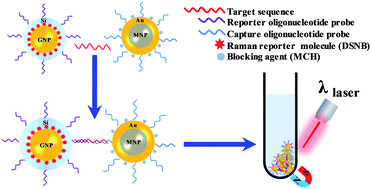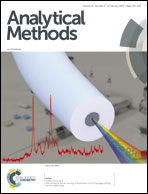A magnetic-based SERS approach for highly sensitive and reproducible detection of cancer-related serum microRNAs
Abstract
This paper describes the combination of silica-coated, analyte-tagged gold nanoparticles (SA@GNPs) and gold-coated paramagnetic nanoparticles (Au@MNPs) in a sandwich assay for the surface enhanced Raman scattering (SERS) detection of cancer-related serum microRNA, miRNA 141. The target sequence is captured by hybridization reactions with complementary oligonucleotide probes conjugated to the SA@GNPs and Au@MNPs, respectively. The resultant hybridization complexes, SA@GNP/miRNA 141/Au@MNP, are removed from solution by using an external magnet. Laser excitation of the concentrated complexes provides a SERS signature spectrum diagnostic for the analyte molecules embedded in the SA@GNPs and specific to the target sequence, miRNA 141. The limit of detection (LOD) for target sequences in serum was 1.8 pM, which is lower by a factor of ∼110 than the previously reported LOD in a similar magnetic-based SERS assay using uncoated, Raman-tagged GNPs as SERS nanotags, which have been demonstrated to suffer signal loss due to the serum protein displacement of Raman analyte molecules on the surface. These results indicate that silica coating plays an essential role in preventing disassociation of Raman reporters from the GNPs, allowing more quantitative and reproducible detection of serum miRNAs than conventional uncoated SERS nanotags.



 Please wait while we load your content...
Please wait while we load your content...